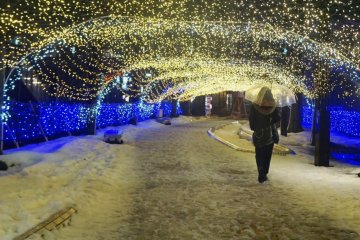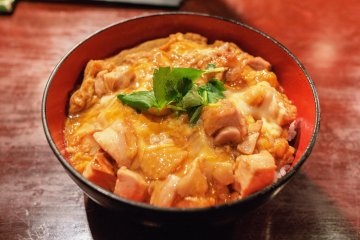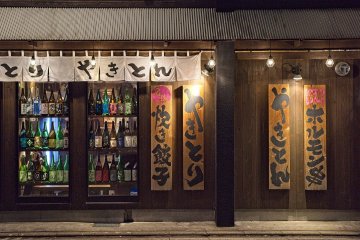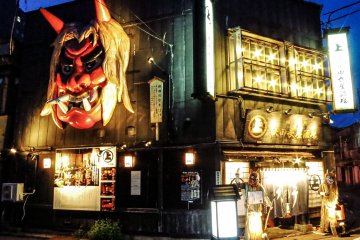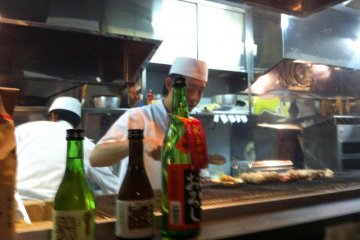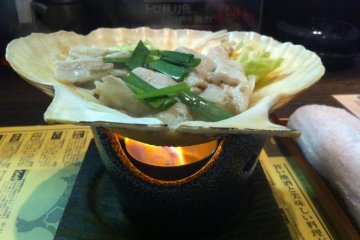Harvests and folklore are interconnected in Akita culture. The Kanto Matsuri, which fills the summer streets with lanterns, dancing and music, originated as a thanksgiving celebration of rice harvests. Each of the hundreds of lanterns skilfully balanced by the master acrobats symbolizes a grain of the Akita-Komachi rice. When you knead cooked rice, you get the main ingredient in Kiritanpo. Like mashed potatoes, you can eat this grilled (like hash browns) or steamed or boiled in a hot pot (nabe), a winter specialty.
Speaking of those dark, dark winters, the starry nights and sometimes howling winds provide fertile ground for many legends to be born. It is said that the Namahage (men in demon masks) stalk around the village threatening spoiled children. Families can appease them by offering wonderful Akita sake, and mesmerized by the sake, the Namahage will give promises of good health and harvest in the New Year, which invariably means more rice, kiritanpo and sake.
Amazingly in the middle of Akita City, I find myself in the midst of country folklore, in no less than a kamakura. Kamakura are the famous snow houses that dot the Akita countryside in winter. The restaurant itself is called Akita Dining/Kamakura-ya. At the entrance I am growled at by two fierce sword wielding Namahage guards. I must have forgotten to bring the Akita sake.
Besides the Kamakura dining rooms, there are also counter seats where you can watch the chefs entertain you in the fiery kitchen. These seats are more likely to be singles and couples as groups are huddled in the famous ice houses.
For the kids the live fish tank will keep them entranced. On this weeknight the crowds are mainly groups of young people enjoying themselves after work. The beer is flowing freely and there is a lively atmosphere. Even though it seats a hundred and ten people, the floor is broken up by the Kamakura dining rooms, giving it a much more intimate atmosphere.
The Kayaki starter is a delectable but light combination of pork strips with cabbage and a really tasty stock of sweet pork juices. It comes with a little candle light cooker, so wait till it finish cooking before you try it. The best bit is when you tip the shell like a soup bowl at the end and drink in the stock, which was intoxicatingly delicious.
Being an izakaya or Japanese pub style restaurant, I then order some yakitori (chicken skewers). The heavy but sweet soy sauce combined with tender chicken thigh fillets make a fantastic accompaniment to Beer or Shōchū.
Then I must have encountered the biggest scallop I have ever eaten, but oh so tender and tasty. The combination of miso and butter taste with drizzle of lemon juice, this is simply made. You definitely should tip the shell afterwards on savour the mixture of juices.
Now for the fire torching of the big stick, otherwise known as kiritanpo. This is theatre for those sitting at the counter with front row view of the proceedings. According to Yuko from the Akita City Tourism Office, I must try some kiritanpo. In the good old days before electricity, charcoal grills reigned supreme, and kiritanpo was flame grilled in front of an open fire, perfect for those long dark Akita winters.
When is bread rice? When is rice bread? With kiritanpo you can have both. It is made from rice but it has the texture of freshly made soft white bread. The miso is fire torched but the sauce is too strong to have by itself. Another reason to double up on the beer. Of course if you like kiritanpo au naturale without miso you can try it in a hot pot style (nabe) pronounced “nah bay”.
Now for dessert, Baba hera ice-cream. “Baba Hera” loosely translates as “Grandma’s own” and the confection has the texture of sherbet, or you might say flavoured snow. It has yellow (banana) and pink (strawberry) "petals" which together resemble a rose. I think it tastes more like bubble gum ice cream. Maybe this is why kids from all over Akita including Yumi from the tourist office have grown up with this dessert.
All up this delicious meal and an insight into Akita folklore costs ¥1,500. This restaurant is part of a loyalty card program where if you eat 3 times in their participating restaurants, you get a voucher for ¥1,000. Effectively one meal free after 3 meals. Who said it was expensive to travel in Japan?



